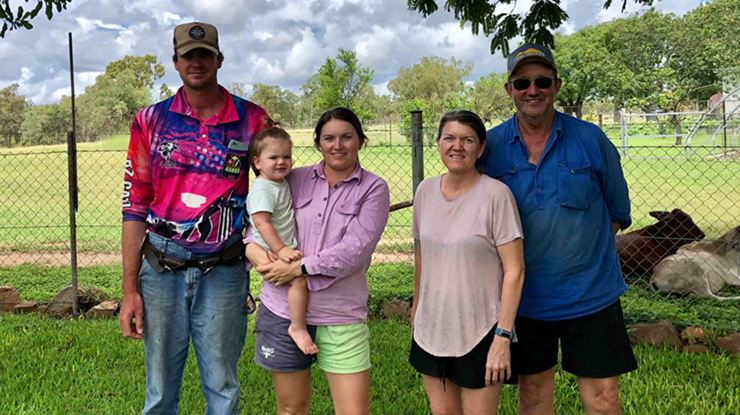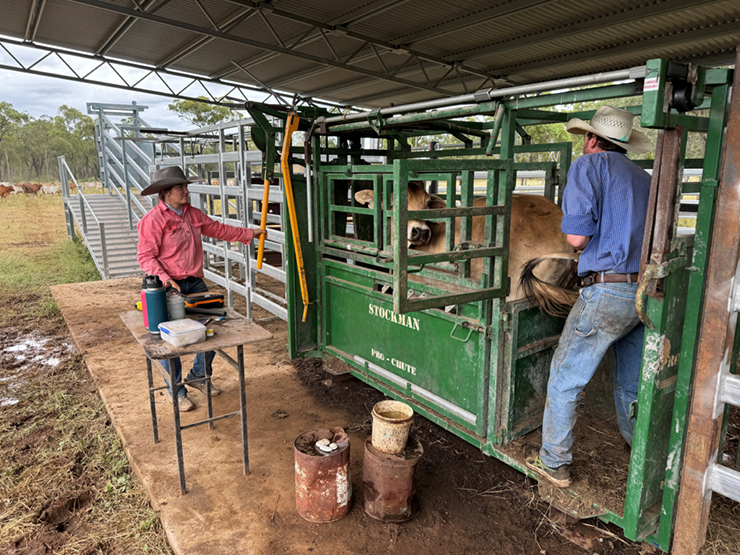 Left to right: Troy and Kellie Pollard and their daughter Oakleigh, with Kayleen and John Healing at their property, ‘Warrawee Station’. Image: Bec Clapperton
Left to right: Troy and Kellie Pollard and their daughter Oakleigh, with Kayleen and John Healing at their property, ‘Warrawee Station’. Image: Bec Clapperton
Tackling herd data together
John and Kayleen Healing’s quest to identify opportunities to improve their Charters Towers beef enterprise was one of the catalysts for joining the Northern Breeding Business (NB2) group.
A second goal was to develop their daughter Kellie and son-in-law Troy’s involvement in the business.
The family, along with six other beef businesses, formed an NB2 group in the Burdekin, led by the Department of Primary Industries, Queensland (DPI).
They soon realised they had a shared goal to improve their on-farm herd recording and data accuracy, so bringing the group’s recording systems into line was an important first step.
A steep learning curve
The group was a mixed bag in terms of how they recorded and analysed their herd data. Some, like the Healings, were using mob-based paddock numbers on paper and experiencing issues with reconciling herd records year-to-year.
The group consensus was clear: the effort required to wrangle numbers into the project’s ‘Herdflow’ template was greater than what was needed to muster cattle out in the paddock.
However, the group’s persistence – under guidance from industry experts and the group’s facilitators – saw them build the skills and confidence to adopt new technology and unearth some new insights into how to improve their businesses.
Getting it right
The nature of the Healing’s country made it easy to miss animals in a muster, posing an additional obstacle to accurate herd data. They moved to an electronic individual identification system – with data collected and recorded for all animals – which Kellie said has made all the difference.
“We were then able to better identify poor performers and confidently cull ‘dead wood’ out of the herd,” she said.
Kellie has now been able to reconcile the annual Herdflow template and address gaps in their records.
“A more accurate recording system means we can now more confidently analyse our herd performance,” Kellie said.
The first year they completed the Herdflow spreadsheet, they only had a 50% calving rate.
Kayleen said this was due to a combination of poor herd data preventing accurate numbers of breeders being recorded and the lack of information on these breeders such as pregnancy and calving rates.
“Since then, using the information we have and culling out poor performers and so on, when Kellie did the Herdflow reconciliation, we had a calving rate of 73%,” Kayleen said.
“We directly attribute this to having better herd data and being able to make those better management decisions over the past three years.”
New ways of working
Kayleen credits the experts involved in the group as another catalyst for change.
“Having access to the technical expertise through NB2 has really accelerated our progress,” she said.
Kellie’s involvement in the course, as the next generation of management, was also an integral to the family’s succession planning process.
“Kellie has now taken on the responsibility of researching, learning and choosing the herd-recording equipment and software and she now looks after all aspects of the herd recording – numbers in paddocks, movements, data reports and so on,” Kayleen said.
“Her organisational and practical skills make her a key part of the business. She’s been more involved in discussions with our bank manager and doing the yearly reporting, which has been really good.”
Reaping the rewards
Improving their data management is already paying off.
“We’re starting to improve our decision making using the data collected. Kellie is now getting some really useful data around pregnancy and mortality rates,” Kayleen said.
“It’s informing decisions on which animals to cull and feed as they’re coming through the yards – something we couldn’t do as well previously
“We actually didn’t know exactly what our calving percentage was before, it was just based on estimates, so now we can get a much better handle on key performance information.”

Kellie and Troy conduct pregnancy testing in the yards at ‘Warrawee Station’. Image: Cam Barnicoat
Learning together
While the Healings had been considering implementing a new herd-recording system for some time, Kayleen credits the support of the group as a key driver of change.
“It galvanised us to take the next step. We learned from each other and became quite tight-knit,” Kayleen said.
Peer support proved to be a significant motivator for group members to persist with and improve their herd recording, while regular producer catch-ups kept them on-track and more likely to commit to making changes.
“I think the best part of being involved in the NB2 is the group of people we now have as part of our network. The level of collective knowledge and trust within the group is so valuable,” Kayleen said.
“The closeness and trust developed within the group has also supported the mental health and wellness of group members – knowing you can talk to each other about things.”
Forward focused
By the end of the Burdekin NB2 program, all businesses had improved the accuracy of their stock numbers and are now ready to analyse their herd performance with confidence.
This includes utilising key performance metrics and benchmarking themselves against regional and industry results.
The Healings plan to continue learning with and supporting their fellow group members beyond the official conclusion of the program.
Many thanks to Bec Clapperton and Lee Beattie for their contributions to this case study.



